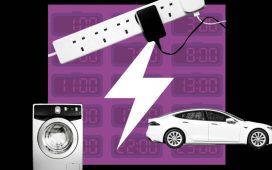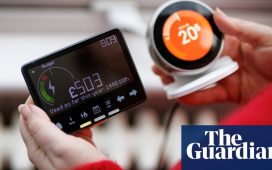The Ofgem price cap is climbing again and will rise to £1,928 a year for a typical annual energy bill in Great Britain when it is adjusted in January.
Soaring energy bills have made the price cap set by the energy regulator a closely watched figure. The bad news is that after dropping back to £1,834 a year in October it is to rise by £94 in January, after a jump in wholesale gas and electricity prices.
This leaves the majority of households facing the coldest months of the year with much higher energy costs than before the pandemic, without government help and limited scope to switch to a cheaper deal.
Simon Francis, a coordinator of the End Fuel Poverty Coalition, said the increase would land at the worst possible time for households.
How is the cap changing?
On 1 January, the price cap set by Ofgem for households in England, Wales and Scotland will go up by 5% to £1,928 a year for the average annual dual-fuel energy bill.
The cap, which is updated every three months, is how much a “typical” household would pay for its energy if the new rate were applied for a full year. For customers who have prepay meters or pay by standard credit (cash or cheque) the cap is slightly higher than for people who pay by direct debit, at £1,960 and £2,058, respectively.
The cap is not the maximum a household can pay, it merely limits how much a supplier can charge for each unit of energy as well as the maximum daily standing charge (flat daily fees charged for a gas and electricity connection regardless of use). Your own bill could be higher or lower because it is based on your actual usage rather than average consumption.
“It’s a timely reminder that inflation might be falling but some prices are still rising,” said Danni Hewson, the head of financial analysis at the investment platform AJ Bell. “For households still trying to work out what yesterday’s autumn statement means for their finances, the news their energy bills are going up once again from January will be a bitter pill to swallow.
“While it might work out at just £7.83 a month, that extra cost comes on top of all the other extra costs and doesn’t come with the government help many families relied on this time last year.”
How does it work?
When it was created in 2019, the cap set out to help customers on their supplier’s standard variable or “default” tariff, ensuring they were not ripped off as a result of sticking with the same supplier year after year. But the energy crisis changed all that: about 30 suppliers went bust and cheap fixes and the switching market disappeared.
Now about 29m households sit on a default tariff whose level is dictated by the cap. Suppliers are restricted in how much they can charge for each kilowatt hour of electricity and gas and also for standing charges.
What about standing charges?
While bills have come down from the level seen at the worst of the cost of living crisis, the cost of energy used is still about double what it was two years ago and standing charges have soared and now contribute about £300 a year a typical dual fuel bill.
The average daily standing charge is 53.37p for electricity and 29.62p for gas. In January, they will come down slightly to 53.35p and 29.6p, which still adds up to roughly 83p a day. Standing charges vary by region, with energy users in Merseyside and north Wales, for example, paying substantially more than those in south-east England.
This month, Tim Jarvis, Ofgem’s director for markets, said it was the “right time” to revisit the contentious issue of high standing charges. Campaigners argue they disproportionately effect lower-income households who spend a greater proportion of their income on energy.
Can I switch to a cheaper energy deal?
In the price cap update, Jonathan Brearley, the Ofgem chief executive, said it was “seeing the return of choice to the market … with a range of tariffs now available offering the security of a fixed rate or a more flexible deal that tracks below the price cap”.
after newsletter promotion
However, this was given short shrift by consumer champion Martin Lewis who tweeted that the assertion was “pushing it a bit”, adding: “There are no standalone cheap fixes that are worth moving to that don’t require you to switch other utilities too.”
Ben Gallizzi of price comparison site Uswitch said the number of fixed deals had increased but remained limited compared with the 100 or so to choose from before the energy crisis.
He said 20 fixed-energy tariffs were available, up from eight in the summer, but some are only open to existing customers. Most of the deals are above the price cap, but some are choosing them for the certainty they offer with 260,000 switching last month – a 70% rise on last year, according to Uswitch.
Are prepayment meters covered?
Yes. The energy costs of about 4 million domestic customers with energy prepayment meters who pay upfront for gas or electricity using an app or by visiting a shop are protected by the cap, but at £1,960 it is £32 more than for those paying by direct debit. These customers used to face a bigger “prepayment premium” until the government stepped in to end it. It is funding a reduction in the gap until April 2024, with Ofgem working on a plan to eradicate it permanently after that.
Why are heat network users out in the cold?
Customers who live in flats with communal heating systems are supplied by a single supplier that procures energy on their behalf. As a result, their supply is considered to be commercial rather than domestic and is not controlled by the cap.
Heat network operators, such as local councils, can apply for help with costs through the government’s energy bill discount scheme. Savings are supposed to be passed on to consumers, and if your supplier secures a discount they must contact you.
If you have not received any money and think you should have, you can complain. You can contact your supplier using a template letter on Gov.uk and if you do not hear back within eight weeks, complain to the energy ombudsman.
What help is available?
Less than before. The £400 energy support given to all households last winter is not being repeated this year, with the government instead making cost of living payments to about 8m vulnerable households. This includes a £900 payment for those on means-tested benefits, £300 for pensioners and £150 for disabled people. The £900 is split into three instalments with the second paid recently. The final payment is scheduled for spring 2024.
If you are struggling, contact your supplier as soon as you can. Under Ofgem rules, suppliers must work with you to agree on a payment plan you can afford. There are different things you should do if you cannot afford to top up your prepayment meter. You should be able to get temporary credit from your supplier. Other options include applying for an energy grant.











